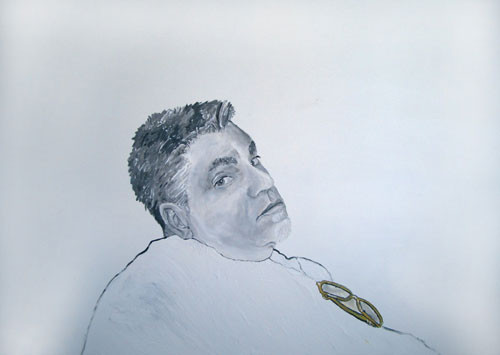Markus Oehlen
23 May - 31 Aug 2007
MARKUS OEHLEN
Works on paper
In his paintings as well as his sculptures and graphic works, Oehlen unfolds a brightly colourful play of forms for the observer: through the introduction of solidly representational figural motives on one hand, and, on the other, the forms’ overall dissolving and blending, the works contain a concentrated tension.
A regularly repeating motive, which already dominated his paintings in the early 1980s, is the human body. Oehlen represents it more or less realistically. He is fond of giving his figures over-dimensioned hands and feet, lending them a peculiarly fantastic touch that is distantly reminiscent of cave paintings and thus, of primal forms. Recently he has also begun to incorporate the motive of the horse and the human skeleton.
Through the years he has absorbed very diverse stylistic influences: following the African exoticism of the 80s, he began intensively to examine the possibilities of computer graphics in the 90s.
All of his phases resonate in his most recent work; in the end, each phase has also enriched his game of dissolving motives. Three methods for dissolving figures are particularly characteristic for Oehlen’s style. The first uses bandages to dissolve the form. The bodies melt, evaporate into nothingness, or let new pictorial motives emerge. A grid is often found in place of the bandage, suggesting parallels to the Op Art of Viktor Vasareli. Computer art is clearly perceptible in the second type of form dissolution, namely figures painted over with transparent red and blue stripes that begin to flicker when viewed, reminding one of pictures on a TV screen. The third characteristic artistic means is the slicing of figures into successive layers. This is a graphic method used in the planning phase of sculpting, and thus refers to Oehlen’s sculptural oeuvre, his three-dimensional works.
Works on paper
In his paintings as well as his sculptures and graphic works, Oehlen unfolds a brightly colourful play of forms for the observer: through the introduction of solidly representational figural motives on one hand, and, on the other, the forms’ overall dissolving and blending, the works contain a concentrated tension.
A regularly repeating motive, which already dominated his paintings in the early 1980s, is the human body. Oehlen represents it more or less realistically. He is fond of giving his figures over-dimensioned hands and feet, lending them a peculiarly fantastic touch that is distantly reminiscent of cave paintings and thus, of primal forms. Recently he has also begun to incorporate the motive of the horse and the human skeleton.
Through the years he has absorbed very diverse stylistic influences: following the African exoticism of the 80s, he began intensively to examine the possibilities of computer graphics in the 90s.
All of his phases resonate in his most recent work; in the end, each phase has also enriched his game of dissolving motives. Three methods for dissolving figures are particularly characteristic for Oehlen’s style. The first uses bandages to dissolve the form. The bodies melt, evaporate into nothingness, or let new pictorial motives emerge. A grid is often found in place of the bandage, suggesting parallels to the Op Art of Viktor Vasareli. Computer art is clearly perceptible in the second type of form dissolution, namely figures painted over with transparent red and blue stripes that begin to flicker when viewed, reminding one of pictures on a TV screen. The third characteristic artistic means is the slicing of figures into successive layers. This is a graphic method used in the planning phase of sculpting, and thus refers to Oehlen’s sculptural oeuvre, his three-dimensional works.

